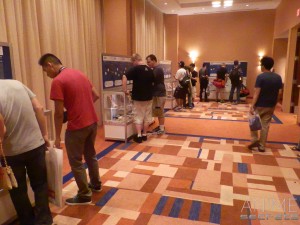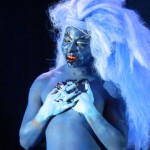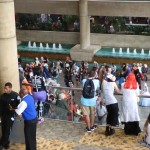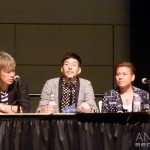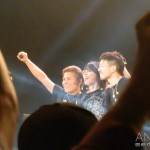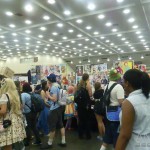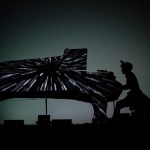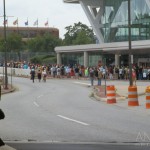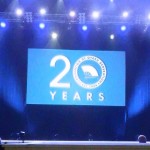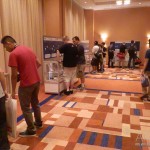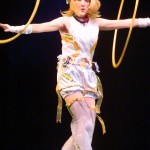Otakon 2013
Baltimore, MD, USA. August 9–11, 2013.
Reporter(s): Miki & Skie
Introduction
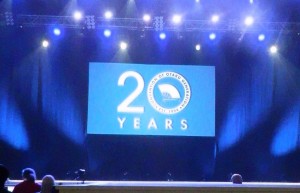 Otakon 2013, held during the second weekend in August, is a massive affair with preliminary attendance numbers for this year’s con hitting a record-breaking 34,100 as of Monday, August 12. Otakon delivers a diverse, fun, and incredibly smooth-running festival with con-goers from around the United States – and beyond – celebrating Japanese culture and art through interactive panels, competitions, and other events. This year’s featured guests included musicians Yoko Kanno and T.M. Revolution, Oreimo author Tsukasa Fushimi, and Oreimo and Sword Art Online animation director Tetsuya Kawakami to name a few, many of which were attending for the first time and bringing with them world premiere screenings or performances. Convention staples such as the Masquerade, Dealer’s Room, and Artist’s Alley were given massive venues that ensured ample opportunity for viewing and shopping – the large spaces also helped keep the infamous Con Funk, a smell associated with enthusiastic but smelly attendees, to a minimum. Other features included multiple Video Rooms, a Dance, a Maid Cafe, and a LARP Venue. All events were included in the purchase of Convention Membership, but only 3-Day passes were sold. Otakon 2014 was announced as being held August 8-10, with a move on the horizon in 2017 as Otakon shifts its venue to the Walter E. Washington Convention Center in Washington, DC. A sister convention will be making its debut in Las Vegas, Nevada on January 3-5, 2014.
Otakon 2013, held during the second weekend in August, is a massive affair with preliminary attendance numbers for this year’s con hitting a record-breaking 34,100 as of Monday, August 12. Otakon delivers a diverse, fun, and incredibly smooth-running festival with con-goers from around the United States – and beyond – celebrating Japanese culture and art through interactive panels, competitions, and other events. This year’s featured guests included musicians Yoko Kanno and T.M. Revolution, Oreimo author Tsukasa Fushimi, and Oreimo and Sword Art Online animation director Tetsuya Kawakami to name a few, many of which were attending for the first time and bringing with them world premiere screenings or performances. Convention staples such as the Masquerade, Dealer’s Room, and Artist’s Alley were given massive venues that ensured ample opportunity for viewing and shopping – the large spaces also helped keep the infamous Con Funk, a smell associated with enthusiastic but smelly attendees, to a minimum. Other features included multiple Video Rooms, a Dance, a Maid Cafe, and a LARP Venue. All events were included in the purchase of Convention Membership, but only 3-Day passes were sold. Otakon 2014 was announced as being held August 8-10, with a move on the horizon in 2017 as Otakon shifts its venue to the Walter E. Washington Convention Center in Washington, DC. A sister convention will be making its debut in Las Vegas, Nevada on January 3-5, 2014.
Crowd Control, Communication, Wayfinding
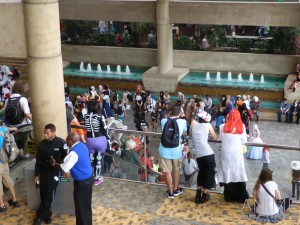 Despite the massive venue and its over 34,000 attendees, Otakon did not feel crowded. It flowed smoothly and quickly with visible effort made to manage crowds. Events and panels with queues were incredibly well-organized with information made available quickly to anyone who asked. Staff members were always visible and pleasant to speak to, making navigating the large Baltimore Convention Center complex very easy. All materials included in the welcome package for con-goers were useful: a glossy book full of guest information, navigation maps, and instructions for competitors was paired with a schedule sheet and a schedule companion that summarized the numerous panels, viewing rooms, and workshops offered. Outside each room, large boards announced the room’s name in huge font alongside a smaller list of the events within, making it easy to spot the necessary rooms for activities through constantly moving crowds.
Despite the massive venue and its over 34,000 attendees, Otakon did not feel crowded. It flowed smoothly and quickly with visible effort made to manage crowds. Events and panels with queues were incredibly well-organized with information made available quickly to anyone who asked. Staff members were always visible and pleasant to speak to, making navigating the large Baltimore Convention Center complex very easy. All materials included in the welcome package for con-goers were useful: a glossy book full of guest information, navigation maps, and instructions for competitors was paired with a schedule sheet and a schedule companion that summarized the numerous panels, viewing rooms, and workshops offered. Outside each room, large boards announced the room’s name in huge font alongside a smaller list of the events within, making it easy to spot the necessary rooms for activities through constantly moving crowds. 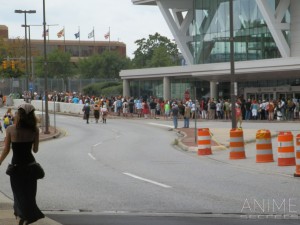 Additional navigation assistance was provided via a schedule app that could be downloaded to mobile devices. The only hiccups encountered were on Friday, when the registration line wound for blocks around the convention center and the bridge between lobbies became a bottleneck that made progress nearly impossible. Things had settled down by late Friday afternoon, however, and it was smooth sailing for the rest of the con. Beyond having to manage the attendees, the staff was also able to work with the ever-changing schedules of the con’s guests. When one of our scheduled interviewees was running too late for us, the press staff made no promises that the guest would be able to meet us, but she (and they) were able to coordinate another time that worked for everyone involved. This may be the exception rather than the rule, but the staff’s clear concerted effort to follow through with reasonable requests, despite being unable to guarantee their fulfillment, was admirable.
Additional navigation assistance was provided via a schedule app that could be downloaded to mobile devices. The only hiccups encountered were on Friday, when the registration line wound for blocks around the convention center and the bridge between lobbies became a bottleneck that made progress nearly impossible. Things had settled down by late Friday afternoon, however, and it was smooth sailing for the rest of the con. Beyond having to manage the attendees, the staff was also able to work with the ever-changing schedules of the con’s guests. When one of our scheduled interviewees was running too late for us, the press staff made no promises that the guest would be able to meet us, but she (and they) were able to coordinate another time that worked for everyone involved. This may be the exception rather than the rule, but the staff’s clear concerted effort to follow through with reasonable requests, despite being unable to guarantee their fulfillment, was admirable.
Panels and Activities
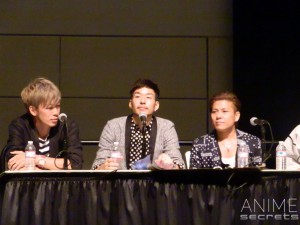 One of the many reasons for attending any convention are its panels and activities, and in this Otakon does not disappoint. The sheer number of panels, the quality of those panels, and the variety of topics was impressive. A few panels ran short on content, but overall the information given out and the interaction between presenters and audience was excellent. Every presenter we saw made an effort to engage with their visitors and what they had to offer was truly interesting, a refreshing change from the lecture or infomercial format one can see in other conventions. Seating was well managed by Otakon Staff as they ushered late arrivals into available seats, and the attendees themselves were highly enthusiastic and friendly, making for a pleasant experience. Notable panels included the Q&A Session with Home Made Kazoku and Real Life of a Manga-ka: Rurouni Kenshin. For more details about the life of a manga-ka, check out the Kaoru Kurosaki Interview!
One of the many reasons for attending any convention are its panels and activities, and in this Otakon does not disappoint. The sheer number of panels, the quality of those panels, and the variety of topics was impressive. A few panels ran short on content, but overall the information given out and the interaction between presenters and audience was excellent. Every presenter we saw made an effort to engage with their visitors and what they had to offer was truly interesting, a refreshing change from the lecture or infomercial format one can see in other conventions. Seating was well managed by Otakon Staff as they ushered late arrivals into available seats, and the attendees themselves were highly enthusiastic and friendly, making for a pleasant experience. Notable panels included the Q&A Session with Home Made Kazoku and Real Life of a Manga-ka: Rurouni Kenshin. For more details about the life of a manga-ka, check out the Kaoru Kurosaki Interview!
Since this was Otakon’s 20th anniversary, they decided to take one of their rooms and dedicate it to the history of the convention. Several glass display cases filled with programs and badges from each of the last twenty years lined the walls, with more descriptive boards showing the timeline of Otakon – each year’s location, dates, attendees, venues, guests, and even weather. It was very interesting to see how much it had grown over the years, what the old con materials looked like, how they were printed, and so much more.
Manga Library
An offering being made by more and more conventions in recent years, the manga library is the print equivalent of the viewing room. After surrendering your badge to the counter, you can request a volume from a wide range of titles. Alongside the usual karaoke-style catalog binder, Otakon’s manga library came complete with a computerized system for staff to track all of the volumes that were checked out at any given time. In terms of the breadth of their collection, they had both newer series and titles old enough to have still been flipped to read left-to-right.
Video Gaming Room
The Gaming Room was spacious and remarkably funk-free. It featured a number of old school and modern gaming systems for connoisseurs of all genres. Tables for card games and RPGs lined one wall while groups of players duked it out on everything from Guilty Gear to Smash Brothers. Several different rhythm games were represented as well, from Rock Band to DDR and beyond. It was surprisingly quiet despite all of the intense gaming going on, and the lines were relatively short thanks to the number and variety of attractions, though that was possibly also helped by our visiting the Gaming Room late at night.
Art Exhibition
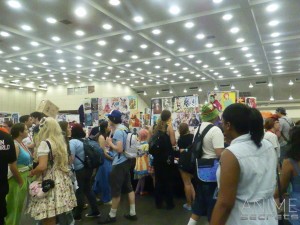 Aside from the regular stalls in Artist’s Alley, the large room also included an area where auctions were held, as well as a small gallery of art by Rurouni Kenshin creator Nobuhiro Watsuki. Curated by his wife and collaborator Kaoru Kurosaki, the exhibition was definitely interesting. Full-size final drafts of pages from his manga, complete with penciled-in lettering and white-out marks, were displayed alongside the completed published pages from the English releases. Kenshin wasn’t the only story by Watsuki displayed either – both art from works produced before and after his most well-known series were displayed chronologically around the inside of the oval-shaped corral of art display boards. Manga pages, concept art, cover art, and compositions for other uses such as DVD art boxes could also be seen. It was an insightful retrospective that shone a light on the creative process and breadth of art that manga creators contribute to their stories.
Aside from the regular stalls in Artist’s Alley, the large room also included an area where auctions were held, as well as a small gallery of art by Rurouni Kenshin creator Nobuhiro Watsuki. Curated by his wife and collaborator Kaoru Kurosaki, the exhibition was definitely interesting. Full-size final drafts of pages from his manga, complete with penciled-in lettering and white-out marks, were displayed alongside the completed published pages from the English releases. Kenshin wasn’t the only story by Watsuki displayed either – both art from works produced before and after his most well-known series were displayed chronologically around the inside of the oval-shaped corral of art display boards. Manga pages, concept art, cover art, and compositions for other uses such as DVD art boxes could also be seen. It was an insightful retrospective that shone a light on the creative process and breadth of art that manga creators contribute to their stories.
Main Attractions
Masquerade
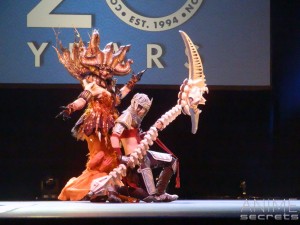 The Masquerade was a three-hour affair held in 1st Mariner Arena where participants in the cosplay competition were presented, followed by over thirty skits and dances by groups competing for a variety of awards, including best in show. Hosted by Jonathan Hawk, who celebrates his 10th year in the role, the skits focused primarily on dance pieces spanning the spectrum from pop culture hits to more dramatic storytelling pieces. Held immediately after the Saturday concert, there was no “room clear” to reset the arena’s seating. Any anticipated problems did not manifest as the switchover was well-handled. Most of the lower seats were filled by the time the event kicked off, a little behind schedule. Notable acts included the Shipping Song, Dance with Wolves, and the audience participation-oriented GoLion dance number. The performances themselves were entertaining and creative. The old adage ‘time flies when you’re having fun’ applied to the entire event, leaving one with a sense of ‘it’s over already?’ when the competitions came to a close. Audience participation was encouraged throughout the event by using the #heymc hashtag on Twitter, where clever comments were announced to the audience and Hawk kept up an amusing commentary between performances. These shout-outs elicited much laughter and whoops from the audience. After the skits concluded, Otaku Idol was held, in which the final two contestants performed and the audience chose the winner.
The Masquerade was a three-hour affair held in 1st Mariner Arena where participants in the cosplay competition were presented, followed by over thirty skits and dances by groups competing for a variety of awards, including best in show. Hosted by Jonathan Hawk, who celebrates his 10th year in the role, the skits focused primarily on dance pieces spanning the spectrum from pop culture hits to more dramatic storytelling pieces. Held immediately after the Saturday concert, there was no “room clear” to reset the arena’s seating. Any anticipated problems did not manifest as the switchover was well-handled. Most of the lower seats were filled by the time the event kicked off, a little behind schedule. Notable acts included the Shipping Song, Dance with Wolves, and the audience participation-oriented GoLion dance number. The performances themselves were entertaining and creative. The old adage ‘time flies when you’re having fun’ applied to the entire event, leaving one with a sense of ‘it’s over already?’ when the competitions came to a close. Audience participation was encouraged throughout the event by using the #heymc hashtag on Twitter, where clever comments were announced to the audience and Hawk kept up an amusing commentary between performances. These shout-outs elicited much laughter and whoops from the audience. After the skits concluded, Otaku Idol was held, in which the final two contestants performed and the audience chose the winner.
Home Made Kazoku & T.M. Revolution Concert
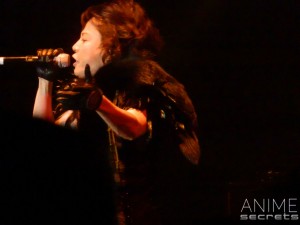 Before the Masquerade on Saturday afternoon, the Arena featured the Home Made Kazoku and T.M. Revolution concert. The lineup for this event began three hours prior to the performance and when seating was allowed, the lines shrank smoothly, filling the lower bowl of the 1st Mariner Arena nearly to capacity with minimal confusion. The crowds were prone to breaking out into chants and organizing multiple rounds of the ‘wave’ in anticipation of the performance, lending the arena a nearly electric buzz. Excitement was running high, only to be whipped up further when Home Made Kazoku took the stage. Known for their pieces in Bleach, Naruto Shippūden, and Eureka Seven, the trio consists of vocalists Micro and Kuro and their DJ, U-Ichi. Upbeat and generally feel-good, the music blended rock and rap with live mixed music to excellent effect. Audience interaction was a strong component in this energetic performance as Home Made Kazoku took the time to speak to the audience, lead them in joining the songs, and even going down into the crowd to give out high-fives. If the Q&A Panel for Home Made Kazoku was any indication, this crowd pleasing trait is normal for the rambunctious and lively trio.
Before the Masquerade on Saturday afternoon, the Arena featured the Home Made Kazoku and T.M. Revolution concert. The lineup for this event began three hours prior to the performance and when seating was allowed, the lines shrank smoothly, filling the lower bowl of the 1st Mariner Arena nearly to capacity with minimal confusion. The crowds were prone to breaking out into chants and organizing multiple rounds of the ‘wave’ in anticipation of the performance, lending the arena a nearly electric buzz. Excitement was running high, only to be whipped up further when Home Made Kazoku took the stage. Known for their pieces in Bleach, Naruto Shippūden, and Eureka Seven, the trio consists of vocalists Micro and Kuro and their DJ, U-Ichi. Upbeat and generally feel-good, the music blended rock and rap with live mixed music to excellent effect. Audience interaction was a strong component in this energetic performance as Home Made Kazoku took the time to speak to the audience, lead them in joining the songs, and even going down into the crowd to give out high-fives. If the Q&A Panel for Home Made Kazoku was any indication, this crowd pleasing trait is normal for the rambunctious and lively trio.
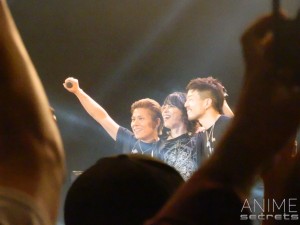 After the break between acts, the chanting rose again as the audience took up the mantra of ‘TMR! TMR!’ and the atmosphere in the room grew to new heights of excitement. When T.M. Revolution finally stepped out on stage, it was in a burst of activity as the lights flared to life and the music silenced the crowd for a few short beats. The cheers were deafening when the audience regained itself and the performance began in truth. Leading off with a recent title from Valvrave: The Liberator, T.M. Revolution featured several songs from his limited edition Otakon CD “Geisha Boy -Anime Song Experience-” including anime tie-ins from Bleach, Gundam SEED, and Rurouni Kenshin. Dramatic and intense, the selection was as iconic as it was varied, repeatedly whipping the audience into a fervor as crowd favourites were performed. More than once, T.M. Revolution raised his mike to the audience to catch them singing along. He too made an effort to communicate with the audience, genuinely excited to be in Baltimore for Otakon, and braved the audience by high-fiving some lucky con-goers.
After the break between acts, the chanting rose again as the audience took up the mantra of ‘TMR! TMR!’ and the atmosphere in the room grew to new heights of excitement. When T.M. Revolution finally stepped out on stage, it was in a burst of activity as the lights flared to life and the music silenced the crowd for a few short beats. The cheers were deafening when the audience regained itself and the performance began in truth. Leading off with a recent title from Valvrave: The Liberator, T.M. Revolution featured several songs from his limited edition Otakon CD “Geisha Boy -Anime Song Experience-” including anime tie-ins from Bleach, Gundam SEED, and Rurouni Kenshin. Dramatic and intense, the selection was as iconic as it was varied, repeatedly whipping the audience into a fervor as crowd favourites were performed. More than once, T.M. Revolution raised his mike to the audience to catch them singing along. He too made an effort to communicate with the audience, genuinely excited to be in Baltimore for Otakon, and braved the audience by high-fiving some lucky con-goers.
When it was time to wind down, the audience drew T.M. Revolution back out for two encore performances, and in one of them he shared the stage with Home Made Kazoku for a brilliant finish. It was the first performance by T.M. Revolution at Otakon in ten years. Home Made Kazoku made their return after three years away. Both expressed interest in returning in the future.
Chiaki Ishikawa & Yoko Kanno Concert
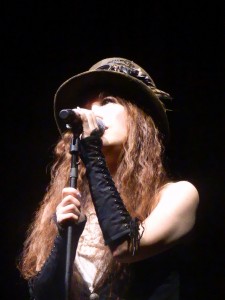 Sunday featured a ticketed concert where Chiaki Ishikawa and Yoko Kanno performed. Ms. Ishikawa opened, performing pieces from her solo work including “Uninstall” from Bokurano. While she performed live on the stage, a simulcast was offered in another room where her image was not actually displayed to those attending. This format seemed odd and there have been complaints about it on the Otakon forums, but Ishikawa’s stage presence was mild and delicate – it was her powerful voice that commanded the audience’s attention throughout her performance. For more information about Chiaki Ishikawa, check out our interview with her!
Sunday featured a ticketed concert where Chiaki Ishikawa and Yoko Kanno performed. Ms. Ishikawa opened, performing pieces from her solo work including “Uninstall” from Bokurano. While she performed live on the stage, a simulcast was offered in another room where her image was not actually displayed to those attending. This format seemed odd and there have been complaints about it on the Otakon forums, but Ishikawa’s stage presence was mild and delicate – it was her powerful voice that commanded the audience’s attention throughout her performance. For more information about Chiaki Ishikawa, check out our interview with her!
Renowned for her works in Ghost in the Shell: Stand Alone Complex, Vision of Escaflowne, and Cowboy Bebop, Yoko Kanno’s performance was nothing short of brilliant. Gracing Otakon with the World Premiere of her latest project, Piano Me, the audience was treated to a feast of sound and light. The arrangements were emotive and complex, playful and carefree, drawing multiple standing ovations from the audience (even in the simulcast room!) throughout her performance. Her entire portion of the concert was a piece of performance art, where the whole of the stage and its contents was the canvas, not just the piano keys. In front of swirling images projected on the stage’s backdrop, the negative space of her piano’s body became a container for atoms, or a heartbeat monitor that danced to her tune, even serving as a jar into which the hearts of her fans – the volume and duration of the applause represented visually – eagerly poured as they demanded more. A feast for the ears and masterfully conducted, Piano Me is a must see for any fan of music or visual art.
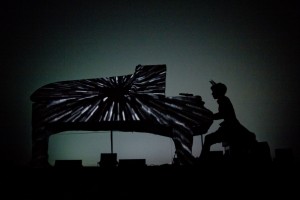
Yoko Kanno’s stage presence was playful, powerful, and casual all at once as she doffed her shoes for comfort and bounced across the stage to prepare Piano-san for the visual component of Piano Me. She took time to engage the audience and react to its many cheers and loud applause, which only caused the fans to applaud even louder. It was an inspiring cycle of interaction between creator and appreciator. While featuring favorites like “Tank!” and “The Real Folk Blues” from Cowboy Bebop, “Gravity” from Wolf’s Rain, and “Fanelia” from Escaflowne is sure to impress, and her original piano pieces were engagingly beautiful on their own and choosing a beautiful rendition of the “Star-Spangled Banner” for her encore piece was completely unexpected. Emotion ran high in the room as voices were raised in praise and appreciation, making for an amazingly powerful experience.
Conclusion
Being the 20th anniversary of the Convention of Otaku Generation, Otakon set out to mark and celebrate this milestone with an event to remember. With enough notable industry and musical guests to tantalize the tastes of any type or class of anime fan, they certainly accomplished their goal. They’ve become much more efficient over the last decade, masterfully managing the Baltimore Convention Center and ensuring that the crowd never feels the 34,000 strong that it is. Otakon is a con that has definitely deserved the reputation it has as one of the biggest and best on the East Coast – or the country – and if they keep this up, they’ll be around for 20 more years to come.
(Writers’ note: We’d also like to thank Kurosaki-san and Ishikawa-san for sitting down to talk with us, and the entire Press Ops team for being so on-top of their game and facilitating these interviews.)

